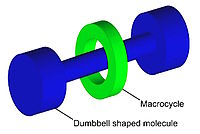Portal:Nanotechnology
From Wikipedia, the free encyclopedia
|
edit
Nanotechnology is very diverse, including extensions of conventional device physics, new approaches based on molecular self-assembly, developing new materials with nanoscale dimensions, and investigating whether we can directly control matter on the atomic scale. Nanotechnology entails the application of fields as diverse as surface science, organic chemistry, molecular biology, semiconductor physics, microfabrication, etc. There is much debate on the future implications of nanotechnology. Nanotechnology may be able to create many new materials and devices with a vast range of applications, such as in medicine, electronics, biomaterials and energy production. On the other hand, nanotechnology raises many of the same issues as any new technology, including concerns about the toxicity and environmental impact of nanomaterials, and their potential effects on global economics, as well as speculation about various doomsday scenarios.
edit
edit
edit
Articles
edit
Categories
edit Nanotechnology | Books | Carbon nanotubes | Cluster chemistry | Companies | DNA nanotechnology | Environment | Fullerenes | Institutions | Journals | Molecular electronics | Molecular machines | Nanoelectronics | Nanomaterials | Nanomedicine | Nanoparticles | People | Publications | Scanning probe microscopy | Supramolecular chemistry
Associated Wikimedia
edit
|



No comments:
Post a Comment